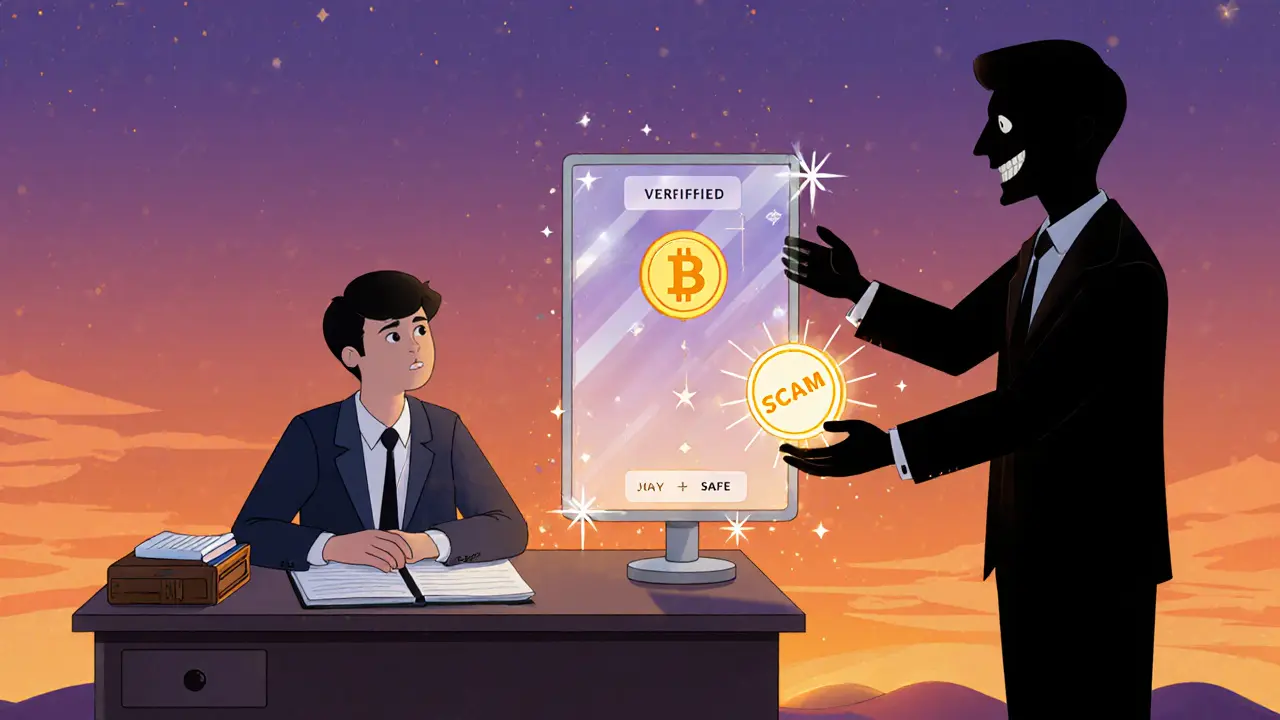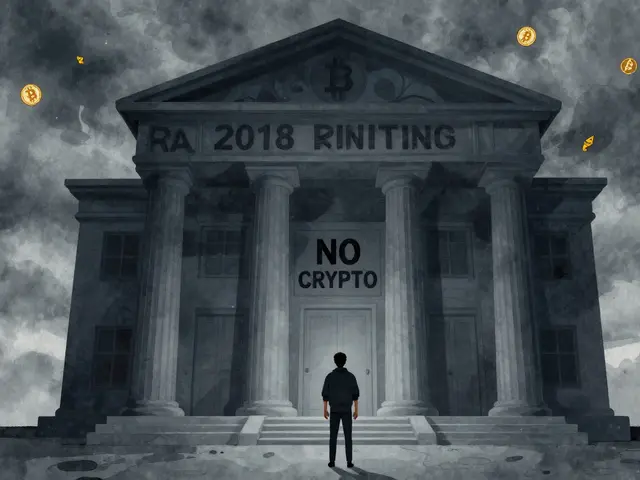CAKEBANK Airdrop Verification Checker
Verify a CAKEBANK Airdrop Claim
Run through our 6-step verification process to determine if a CAKEBANK airdrop is legitimate.
Verification Checklist
You've probably seen the buzz about an CAKEBANK airdrop and are wondering whether it's worth your time. The reality is a mix of speculation, thin public data, and typical crypto‑airdrop mechanics. This guide breaks down everything you can verify today, shows how a legit airdrop usually works, and gives you a checklist so you don't fall for a scam.
Quick Takeaways
- CAKEBANK is a micro‑cap token priced around $0.00000207 USdollars.
- No official roadmap or public announcement about an airdrop exists yet.
- Legitimate airdrops normally define eligibility, distribution dates, and a clear token allocation.
- Use the 6‑step verification checklist below before sharing wallets or personal data.
- Watch the regulatory landscape - U.S. users may face tax or compliance hurdles.
What Is CAKEBANK?
CAKEBANK is a cryptocurrency token that trades on several decentralized exchanges. At the time of writing (Oct112025) it sits at roughly $0.00000207 USD per token, down about 5.84% over the past 24hours. The token’s market cap is under $2million, which places it in the “micro‑cap” tier - meaning liquidity is thin and price swings can be extreme.
Who Is Behind the Token?
The issuing entity is Cake Bank, a project that claims to blend decentralized finance (DeFi) services with a community‑driven token model. Public documentation is sparse: there is a bare‑bones website, a Telegram channel with a few hundred members, and no audited smart‑contract code publicly linked. This low‑visibility approach is a red flag for many investors.
Understanding Crypto Airdrops
An airdrop in the crypto world is a free distribution of tokens to a group of users, usually as a marketing push or to reward early supporters. Airdrops can be:
- Holder‑based: you must own a specific token before a snapshot date.
- Task‑based: you complete actions like retweeting, joining a Discord, or providing liquidity.
- Random: a lottery‑style draw among eligible participants.
Legitimate programs publish the eligibility criteria, the total token pool allocated for the airdrop, and a timeline for distribution. They also provide a clear method for claiming tokens-usually through a smart‑contract interaction or a web portal that never asks for private keys.
Why Information on the CAKEBANK Airdrop Is So Thin
Searches across crypto news outlets, official project channels, and major community forums turn up virtually nothing about a planned CAKEBANK airdrop. Possible explanations include:
- It is still in early planning and has not been publicly announced.
- The airdrop is limited to a narrow audience (e.g., regional users or private investors).
- The project has already run a one‑off distribution that went unnoticed.
- There is no airdrop at all, and the buzz is driven by speculation or rogue promoters.
Without an official statement, you can’t rely on rumors. The safest route is to verify directly with the source.
Typical Airdrop Mechanics (Real‑World Examples)
To give you a sense of what a well‑structured airdrop looks like, here are two recent programs:
- PancakeSwap (CAKE) ran a bi‑weekly $4,200‑worth airdrop for Coinbase One members who kept at least $100 in trading volume on BNB Chain, Base, or Arbitrum. The program lasted from July232025 to mid‑October, with a total war‑chest of $25,000 in CAKE tokens.
- Binance Megadrop (KernelDAO) launched its fourth phase on April92025, offering up to 40million KERNEL tokens (4% of total supply). The distribution required users to stake BNB on Binance and pass a KYC check.
Both programs shared these traits: a transparent allocation amount, clear eligibility (trading volume or staking), a public claim portal, and a timeline disclosed in advance.
How to Verify a Potential CAKEBANK Airdrop
If you encounter a post claiming a free CAKEBANK giveaway, run through the following six‑step checklist before taking any action:
- Check the official channels. Visit the official Cake Bank website, their verified Twitter/X handle, and the Telegram community. Look for an announcement that matches the claim.
- Validate the smart contract. A genuine airdrop will point to a contract address on BscScan or Etherscan. Verify that the contract is verified (source code published) and that the token name matches CAKEBANK.
- Look for KYC or wallet‑connect requirements. Scams often ask for private keys or seed phrases. Legitimate programs only ask you to connect a wallet via a read‑only method.
- Cross‑reference with reputable news sites. Outlets like CoinDesk, The Block, or CryptoSlate usually cover sizable airdrops. Absence of coverage should raise suspicion.
- Assess the token economics. With a price of $0.00000207, a “generous” airdrop would need to distribute billions of tokens to be worthwhile. Ask whether the allocation makes sense for the project’s market cap.
- Consider regulatory impact. In the United States, airdropped tokens are treated as taxable income at fair market value when received. Ensure you’re ready to report them.
Red Flags Specific to CAKEBANK
- No verifiable whitepaper or audited code.
- Social media presence limited to a few hundred followers with no engagement on official announcements.
- Any claim that you need to send CAKEBANK tokens to a “distribution address” - you’ll lose the tokens.
- Promises of massive returns (e.g., “receive 10,000 CAKEBANK for free”) without a clear token supply rationale.

Comparison Table: Known Airdrops vs. Potential CAKEBANK Airdrop
| Feature | PancakeSwap (CAKE) | Binance Megadrop (KERNEL) | Potential CAKEBANK |
|---|---|---|---|
| Eligibility | Coinbase One members with $100+ volume | BNB stakers + KYC | Unclear / No public criteria |
| Token Allocation | $4,200 worth every 2weeks | 40M KERNEL (4% supply) | Unknown, likely micro‑cap |
| Distribution Timeline | Bi‑weekly (July-Oct2025) | Started Apr92025, phase‑based | Not announced |
| Claim Method | Web portal - wallet connect | Binance UI - automatic credit | Not disclosed |
| Regulatory Note | Taxed at receipt (US) | Taxed at receipt (US) | Likely taxable, but no guidance |
Next Steps If You’re Interested
Assuming you’ve run the verification checklist and still want to keep an eye on CAKEBANK, follow these practical steps:
- Join the official Telegram and Discord (if available) and enable notifications.
- Set up a dedicated hardware wallet (Ledger, Trezor) to receive any future airdrop safely.
- Track the token’s price and volume on BscScan or CoinGecko daily.
- Subscribe to reputable crypto newsletters that cover airdrop alerts.
- Prepare a tax spreadsheet: record the fair market value on the day you receive any tokens, and note the transaction hash.
By staying disciplined, you’ll avoid the common pitfalls that trap newcomers to the airdrop space.
Final Thoughts
At the moment, the CAKEBANK airdrop is more rumor than reality. The token itself exists, but an official, transparent distribution plan does not. Treat any unsolicited claim with caution, do your due diligence, and remember that the safest airdrop is the one that publishes every detail on a verifiable platform.
Frequently Asked Questions
Is there an official CAKEBANK airdrop right now?
No. As of October2025 there is no public announcement from the Cake Bank team about any ongoing or upcoming airdrop.
How can I tell if a CAKEBANK airdrop claim is a scam?
Look for the six‑step verification checklist: official channel announcement, verified contract address, no private‑key requests, coverage by reputable news sites, sensible token economics, and clear tax information.
Do I need to pay taxes on a crypto airdrop?
In the United States, airdropped tokens are treated as ordinary income at the fair market value on the day you receive them. You must report that amount on your tax return.
What wallet should I use to claim a legitimate airdrop?
A non‑custodial wallet that supports the blockchain the token lives on (e.g., MetaMask for BSC, Trust Wallet). Never share your seed phrase; only connect via a read‑only wallet‑connect prompt.
Can I trade CAKEBANK on major exchanges?
Currently CAKEBANK is only listed on a handful of decentralized exchanges. It has no presence on Binance, Coinbase, or other major centralized platforms.
Where can I find the official token contract?
Check the Cake Bank website for a link to BscScan. The verified contract address is listed under the “Token” tab. Verify the contract name matches CAKEBANK.







Laura Myers
October 11, 2025 AT 09:16If you think the CAKEBANK hype is just another meme, think again – the token’s micro‑cap status could mean massive upside for anyone who catches the airdrop before it vanishes into the ether. The article lays out a solid checklist, but the real work begins when you actually scramble to verify those six steps yourself.
Leo McCloskey
October 18, 2025 AT 21:49Indeed, the checklist is comprehensive; however, one must consider the broader ecosystem implications, the tokenomics viability, and the regulatory labyrinth that governs airdrops – all of which are frequently overlooked by casual observers; furthermore, the lack of audited smart‑contract code presents a non‑trivial risk vector, especially when juxtaposed with the token's sub‑$0.000003 price point.
arnab nath
October 26, 2025 AT 10:23They hide the airdrop behind fake bots and bogus telegram links.
Nathan Van Myall
November 2, 2025 AT 22:56The absence of an official announcement is a red flag; verify every claim against the primary sources before you even think about connecting a wallet.
debby martha
November 10, 2025 AT 11:29i dont trust any of this, looks like a scam to me.
Ted Lucas
November 18, 2025 AT 00:03Alright, listen up, crypto fam! 🎉 The CAKEBANK airdrop rumor mill is churning louder than a Bitcoin meme on a Saturday night, but you’ve got to separate the hype from the legit! First, hit the official Cake Bank socials – if they haven’t posted about an airdrop, that’s a huge orange flag. Second, scan the contract on BscScan; a verified source code is the only green light you’ll see. Third, never, ever hand over your private key – even a “trusted” DM is just a clever phishing hook. Fourth, reputable news outlets like CoinDesk or The Block will usually run a piece if the airdrop is massive; silence suggests it’s a whisper campaign. Fifth, compute the token economics – at $0.00000207, a “generous” drop would require billions of tokens, which would massively dilute the supply and likely tank the price. Sixth, remember the tax implications – the IRS treats airdropped tokens as ordinary income, so you’ll need to report the fair market value on the day you receive them. Lastly, set up a hardware wallet for any real distribution, and keep your seed phrase offline. Follow these steps and you’ll dodge most scams. Stay sharp, stay safe, and may your gains be glorious! 🚀
Carol Fisher
November 25, 2025 AT 12:36Patriotic heads up: if you’re an American, keep your funds in USA‑based wallets and watch out for foreign scams 🇺🇸🚨.
Melanie Birt
December 3, 2025 AT 01:09For anyone still on the fence, the six‑step verification is your best defense. Double‑check the contract address on BscScan, verify the team’s official channels, and never share private keys. If all criteria are met, you can proceed with confidence.
Ethan Chambers
December 10, 2025 AT 13:43While the community celebrates the so‑called “airdrop”, I find it amusing how quickly the herd jumps onto anything that smells like free money, forgetting that most of these projects lack substance beyond a flashy logo.